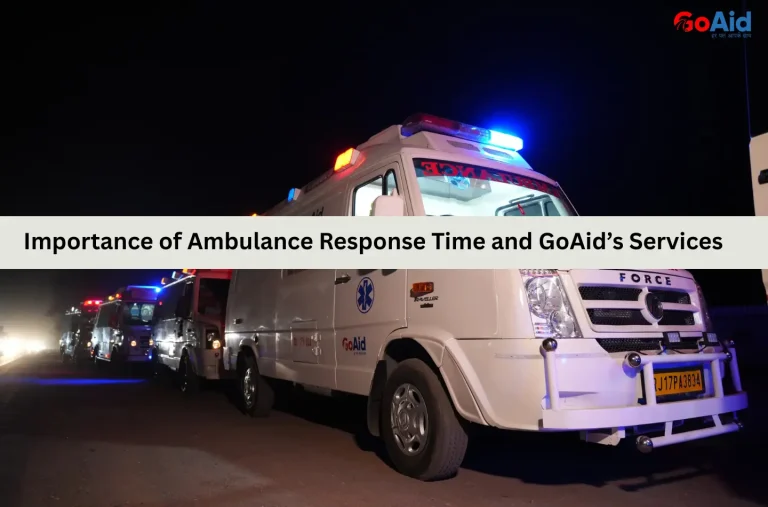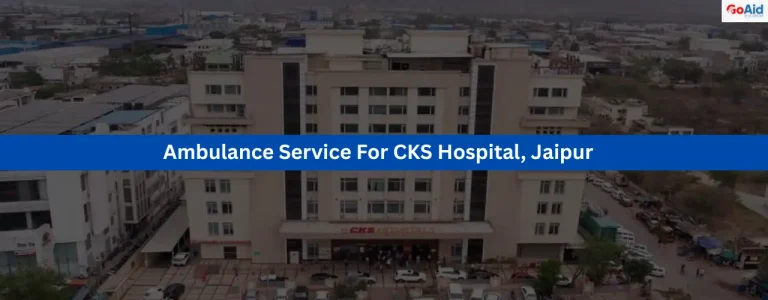In ambulance dispatch, the integration of AI and predictive analytics is transforming emergency healthcare in India. GoAid Ambulance Service ensures real-time route optimization and faster response times by adopting smart technology.
These innovations in prehospital emergency care allow GoAid to provide reliable, 24/7 support. This ambulance service ensures that patients receive immediate medical attention through its 10-minute ambulance service across major Indian cities.
What Is AI and Predictive Analytics in Ambulance Dispatch?
Artificial Intelligence (AI) in ambulance dispatch refers to the use of smart algorithms and real-time data to make quick, efficient decisions during emergencies. When combined with predictive analytics, it allows systems to analyze patterns such as accident-prone areas, peak emergency hours, and hospital capacity.
This integration helps GoAid Smart Ambulance Service predict demand, optimize routes, and reduce delays. Essentially, predictive analytics turns data into action, enabling real-time AI systems for ambulance routing and enhancing overall emergency healthcare efficiency.
Importance of AI Integration in Ambulance Dispatch Systems
Integrating AI into ambulance dispatch systems is transforming emergency response by making it faster, more efficient, and data-driven. GoAid Ambulance Service leverages this technology to enhance reliability, patient safety, and overall emergency care delivery.
- Faster Response Time: AI algorithms analyze traffic and distance in real-time, helping GoAid ambulances reach patients within minutes, ensuring immediate medical assistance during critical emergencies.
- Smart Route Optimization: AI-driven mapping tools select the fastest, least congested routes, reducing travel time and improving patient outcomes in high-stress emergency conditions.
- Predictive Emergency Demand: Predictive analytics identifies high-risk zones and peak hours, allowing GoAid to position ambulances strategically for quicker response and better coverage.
- Real-Time Resource Allocation: AI monitors ambulance availability and hospital capacity, ensuring patients are directed to the nearest suitable medical facility without delay.
- Enhanced Communication: AI systems connect dispatchers, paramedics, and hospitals seamlessly, improving coordination and minimizing response time during life-saving operations.
- Data-Driven Decision Making: AI collects and analyzes emergency data, enabling GoAid to refine its operations, boost efficiency, and continuously improve service quality.
- Improved Patient Care: By integrating AI insights, GoAid ensures precise triage, better preparedness, and timely interventions, leading to superior prehospital emergency care.
Predictive Analytics – Powering the Future of Emergency Care
Predictive analytics is revolutionizing emergency medical services by forecasting demand, identifying high-risk areas, and optimizing ambulance deployment. It empowers GoAid Ambulance Service to make faster, data-driven decisions and enhance patient survival rates.
These predictive tools ensure proactive readiness by analyzing historical trends and real-time data. This makes emergency care smarter, more efficient, and future-ready across India.
How GoAid Ambulance Service Is Leveraging AI & Predictive Analytics
GoAid Ambulance Service is harnessing the power of AI and predictive analytics to transform emergency healthcare. These technologies enable faster dispatch, efficient coordination, and improved decision-making, ensuring patients receive life-saving care in record time.
- Smart Dispatch Algorithms: GoAid uses AI algorithms that instantly assign the nearest ambulance, minimizing delay and improving the response time during emergencies.
- Real-Time Traffic Analysis: AI systems analyze live traffic data, allowing GoAid to select the quickest route and avoid congestion for timely patient transport.
- Predictive Demand Forecasting: Predictive analytics identifies emergency hotspots and busy hours, helping GoAid deploy ambulances strategically for maximum coverage.
- Dynamic Fleet Management: AI monitors ambulance location, status, and readiness, ensuring efficient resource utilization and reduced idle time.
- Seamless Hospital Coordination: AI integration helps GoAid connect with nearby hospitals, sharing patient updates and ensuring immediate medical attention upon arrival.
- Data-Backed Performance Improvement: GoAid uses analytics to review service patterns, refine dispatch strategies, and continually improve ambulance operations.
- Personalized Patient Care: Predictive insights allow GoAid to anticipate patient needs and provide the right ambulance type and medical equipment for each emergency.Humanize 264 words
Benefits of AI-Driven Ambulance Dispatch for Patients and Healthcare Providers
Integrating AI into ambulance dispatch delivers immense value to both patients and healthcare providers. GoAid Ambulance Service leverages smart systems to ensure faster responses, accurate decision-making, and efficient emergency medical coordination for improved care outcomes.
- Reduced Response Time: AI enables GoAid to assign the nearest ambulance instantly, minimizing wait times and improving patient survival chances during emergencies.
- Enhanced Route Planning: Real-time AI mapping avoids traffic delays, ensuring ambulances reach hospitals quickly and efficiently.
- Improved Resource Utilization: Predictive analytics helps GoAid manage ambulances effectively, ensuring optimal coverage and minimal downtime.
- Better Communication: AI connects paramedics, dispatchers, and hospitals in real time, improving coordination and treatment readiness.
- Increased Patient Safety: Smart data systems ensure accurate triage, patient monitoring, and immediate transfer to the right healthcare facility.
- Cost Efficiency: AI reduces unnecessary travel and fuel costs, making GoAidŌĆÖs services affordable without compromising quality.
- Enhanced Healthcare Delivery: By streamlining logistics, AI ensures hospitals receive patients faster, enabling timely interventions and better outcomes.
Challenges of AI and Predictive Analytics in Ambulance Dispatch
AI and predictive analytics offer numerous benefits, but they also present challenges in integration, reliability, and security. GoAid Ambulance Service acknowledges these hurdles and continues to innovate for a more efficient and dependable emergency response system.
- Data Privacy Concerns: Managing sensitive patient information securely while using AI systems remains a significant challenge for ambulance services.
- High Implementation Costs: Advanced AI infrastructure requires substantial investment in technology, training, and maintenance.
- Technical Reliability Issues: Dependence on AI systems increases risks if there are software glitches or data connectivity failures.
- Integration Challenges: Combining AI tools with existing dispatch systems demands technical expertise and continuous optimization.
- Limited Data Accuracy: Incomplete or outdated data can affect predictive analytics results, leading to incorrect dispatch decisions.
- Need for Skilled Workforce: Operating AI-driven systems requires trained staff who understand technology and emergency care coordination.
- Regulatory and Ethical Concerns: Ensuring compliance with healthcare regulations and maintaining ethical AI use is essential for safe implementation.
Why GoAid Is the Best Smart Ambulance Provider?
GoAid Ambulance Service stands out as IndiaŌĆÖs most advanced and reliable smart ambulance provider. Through cutting-edge technology, rapid response, and compassionate care, GoAid ensures patients receive the fastest, safest, and most efficient emergency medical support.
- 10-Minute Response Time: GoAid guarantees quick dispatch, reaching patients within just 10 minutes of booking for immediate medical assistance.
- AI-Powered Dispatch System: Smart AI tools help GoAid allocate the nearest ambulance, optimize routes, and reduce response delays efficiently.
- Nationwide Coverage: Operating across major cities, GoAid ensures consistent ambulance service availability 24/7, anywhere in India.
- Multiple Ambulance Types: GoAid offers Normal, BLS, ALS, ICU, Mortuary, and Air Ambulances to meet every medical need.
- Real-Time Tracking: Advanced GPS technology enables families to track ambulance movement live, ensuring transparency and trust.
- Experienced Medical Team: Skilled paramedics and trained staff provide expert care during every transport, ensuring patient safety and comfort.
- Affordable Rates: GoAid offers cost-effective, government-approved ambulance charges with multiple booking options, via app or by calling 8008280020.
Future of AI Emergency Medical Transport
The future of AI in emergency medical transport is set to redefine how healthcare responds to crises. Predictive analytics, machine learning, and real-time data integration will enable ambulances to arrive faster, identify patient needs before arrival, and improve treatment coordination with hospitals.
GoAid Ambulance Service is already leading this transformation by embracing smart dispatch systems, automated tracking, and data-driven decision-making, ensuring India moves toward a fully intelligent and responsive emergency healthcare network.
Conclusion to the Integrating AI and Predictive Analytics in Ambulance Dispatch
Integrating AI and predictive analytics in ambulance dispatch is revolutionizing emergency response. GoAid Ambulance Service leads this innovation by offering faster, smarter, and data-driven emergency care, ensuring every patient receives timely, efficient, and life-saving medical support across IndiaŌĆÖs rapidly evolving healthcare landscape.
FAQs Related to Integrating AI and Predictive Analytics in Ambulance Dispatch
Question 1: What is AI integration in ambulance dispatch?
Answer: AI integration in ambulance dispatch uses smart algorithms and real-time data to optimize routes, allocate ambulances efficiently, and improve emergency response times.
Question 2: How does predictive analytics help in emergency healthcare systems?
Answer: Predictive analytics identifies high-risk zones and demand patterns, helping GoAid Ambulance Service position ambulances strategically for faster and more accurate responses.
Question 3: What is the role of AI in prehospital emergency care?
Answer: AI enhances prehospital emergency care by enabling quick decision-making, optimizing routes, and improving patient outcomes through real-time monitoring and coordination.
Question 4: How does GoAid use AI in ambulance dispatch?
Answer: GoAid Ambulance Service leverages AI for real-time ambulance tracking, smart route optimization, and predictive demand analysis to ensure a 10-minute emergency response.
Question 5: What are the benefits of AI-driven ambulance systems?
Answer: AI-driven systems offer faster response, better resource allocation, enhanced patient safety, and improved communication between ambulances, dispatchers, and hospitals.
Question 6: Is AI the future of ambulance services in India?
Answer: Yes, AI and predictive analytics are shaping the future of emergency medical transport, making services like GoAid Smart Ambulance faster, safer, and more efficient.















